Nedra Bonds: The angry quilter
- Published
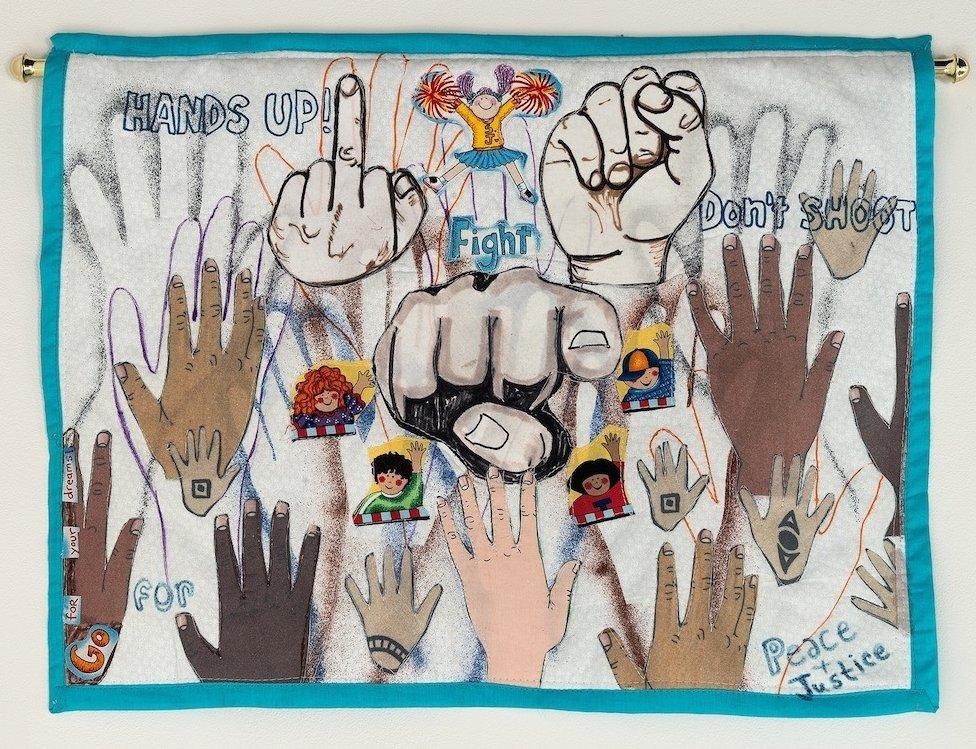
Numerous protests have taken place since the shooting of Michael Brown in Ferguson, Missouri, in August 2014, but only one has taken the form of a handmade quilt. Its creator, Nedra Bonds, explains the motivation behind her design and talks about a lifetime of teaching, protesting and stitching.
Around the time of the shooting of Michael Brown in Ferguson, Missouri, I heard an interview with a teacher on public radio.
He related how he had conducted an experiment, in which he went into elementary school classes and said to the children, "Assume the position!" And fourth graders knew what that meant - get up against the wall with your hands up.
That is amazing to me, and so, so sad.
Children should only have to put their hands up to ask questions in class or give an opinion. And they should use their fists for cheering on their team, not fighting in the streets.
That was why I put these little cheerleaders in the quilt I made for Ferguson, which I called The Finger and The Fist.
Find us on Facebook , external
They say there are a few people who make things happen, more people who watch things happen, and a whole lot more who ask: "What just happened?"
That's why I say the quilt is about you. What are you going to do? What are you going to think? What are you going to say?
I have watched people react in different ways. Some engage with it. Some turn away. Some laugh. Those who know me say, "Oh that's just Nedra!"
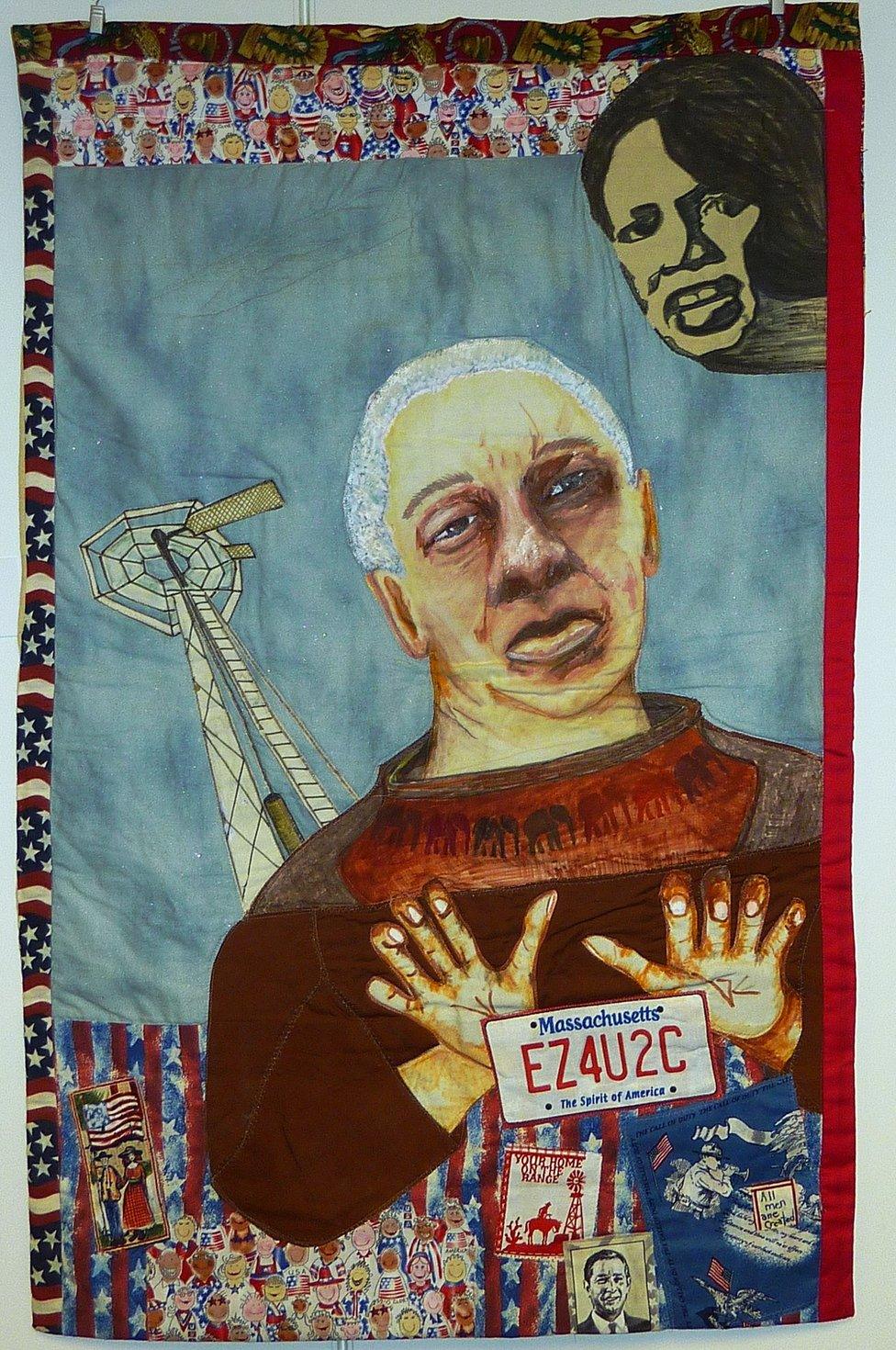
Bonds' satirical quilt EZ4U2C depicted Colin Powell as Don Quixote
I'm 68, but I still keep blank placards and marker pens in the back of my car in case I need to stop and picket somebody. I've got a sewing machine in there too, because I've found you never quite know when a situation might arise in which one is required. I call this "being ready".
The point is, if I went out on the street and said those words, "Hands up, don't shoot!", people would get angry. This is a way of creating a tension without intimidating anyone. It's just fabric, after all. When we come into this world they wrap us in a cloth. When we leave the world, they wrap us in a cloth. It's just fabric!
I come from a long line of quilters, on both sides of my family. In the US, all sorts of people have a tradition of quilt-making, including black communities. My mother and father made a quilt together as part of their courtship ritual. Then, when I was six, I was told by my grandparents: "You have to do this, because this is who we are."
So I learned to make 10 stitches to the first joint in my finger, and if I didn't do 10 then I had to take them out and do them over again.
I hated the whole thing. My family created quilts based on patterns printed in our local paper, the Kansas City Star. But I loathed the matching edges and the matching points, and I thought it was stupid to take perfectly good fabric, cut it up and sew it back together again.
As soon as I could, I gave up quilting to raise hell in all sorts of ways that were meaningful for me at the time. Letter-writing, sit-ins, you name it. It was the 1960s and the civil rights movement.
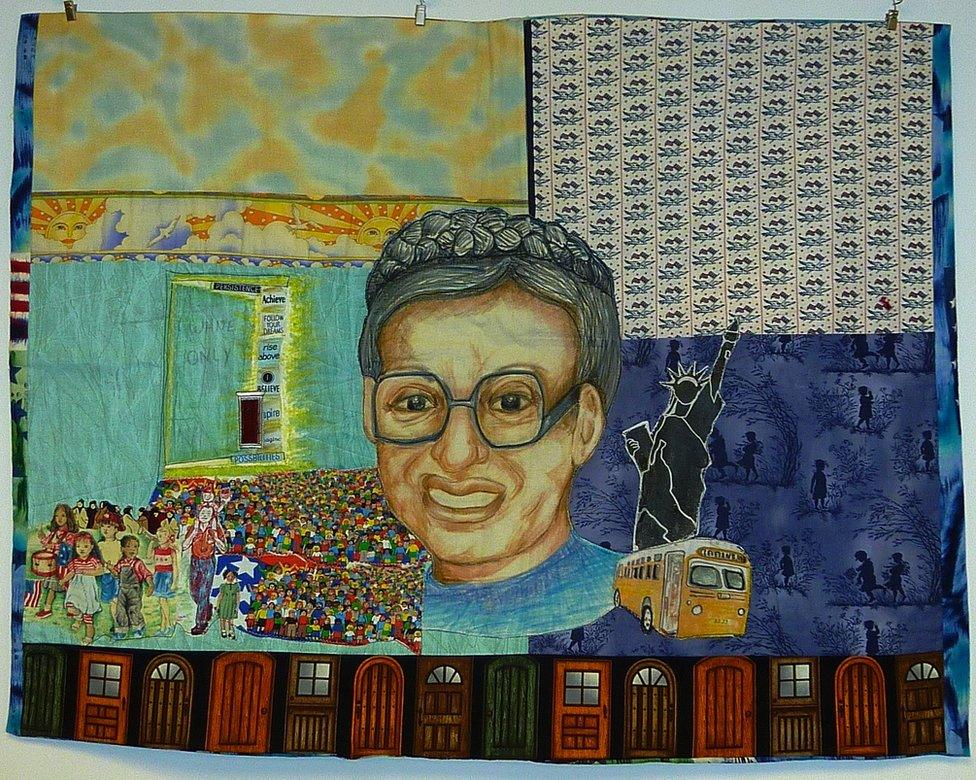
Nedra Bonds' quilt for the civil rights movement depicts Rosa Parks, the bus boycott and a series of closed doors to represent opportunities shut off to black people
It wasn't until 1989 that I found myself making a quilt again. This is how it happened.
I grew up near Quindaro, an abandoned settlement on the outskirts of Kansas City. In the 1850s, Quindaro sat on the brink of Kansas Territory, and just across the river lay Missouri, a slave state. According to oral tradition, the township became an important staging post in the Underground Railroad - the network of routes that black people used to escape slavery - and the runaways hid with farmers in Kansas before escaping to Nebraska and freedom.
Quindaro was abandoned during the civil war, and it never properly recovered. Then in the 1980s the authorities in Kansas City thought it would be a good idea to put a sanitary landfill dump on the site. I was one of a group of people who decided that we couldn't let that happen.
I don't really know why I chose to make a quilt as part of this campaign, which went on for eight years. Perhaps it was because there was no visual record of the railroad. Also, I had it in mind that a quilt might be a good way to engage the kids at Quindaro school with their history.
So I created this quilt that showed the history of Quindaro, starting with a picture of John Stuart, the minister who preached to the Wyandot Indians who later settled the area, and turned some of them into abolitionists.
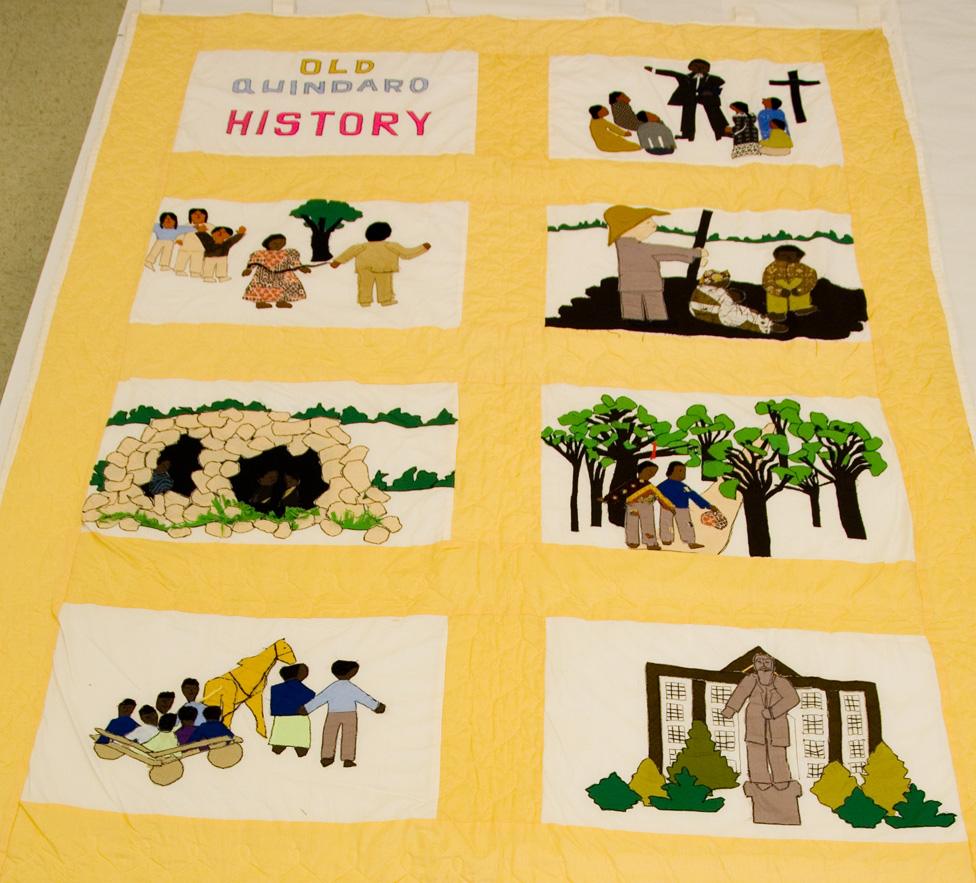
Nedra's Quindaro History Quilt shows John Stewart preaching to the Wyandot Indians, abolitionists crossing the Missouri River, runaway slaves hiding in caves and the John Brown statue at Western University
The city council met every two weeks. If you got something put on the agenda you could have five minutes to say whatever you wanted to say. For my five minutes I always got out my quilt and someone held it while I walked and talked and yelled about how it was a travesty to throw all that away in the name of a landfill.
The councillors soon grew tired of us coming every two weeks to talk about the same thing, and at one point the mayor even said to me: "You will no longer come here and talk about this issue, because I don't want to hear about it any more."
So I came back with a copy of the US constitution, one of those little copies that Khizr Khan got out at the Democratic Convention this year. And I said, "You know, I'm not real smart - I came through Kansas City schools, after all - but they did teach me how to read and I read this right here: that you can't tell me what I can say and what I can't say. You have to meet in public and it is my constitutional right to come before you. I have five minutes."
The more they dissed me, the madder I got. I mean they really told me, you know, you're nobody, all you do is women's work and you don't know anything. I confess that it got to the point where I did act up. I have Native American blood in me, and I would put on my costume and create a scene. Why not? They didn't want to hear what I had to say, so I was going to make it interesting for them.
Anyway, all of this got reported in the paper and my quilt and I became well-known in Kansas City.

Find out more
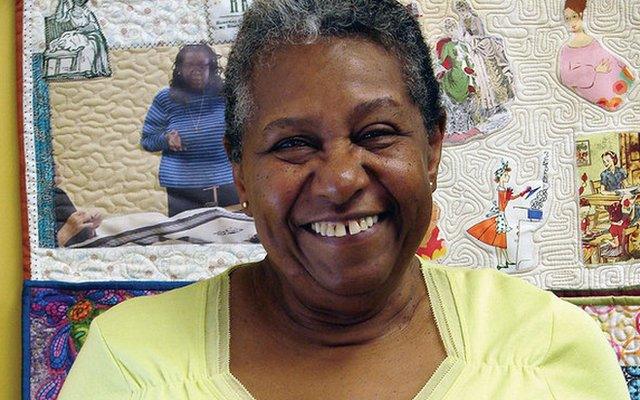
Listen to Nedra Bonds speaking to Outlook on the BBC World Service
Get the Outlook podcast for more extraordinary real-life stories

Three of our state representatives at the time were Wisdom, Justice and Love. Those were truly their last names and I went and saw each one. Wisdom was a state senator and he said to me, "When I was a child I used to sit with my grandmother and tie the knots when she made quilts," and he got emotional.
So there I was, sitting in Topeka, Kansas, talking to this big white guy who's crying about his grandmother's quilt. And I'm thinking, "OK, well I think I got him at least!"
Wisdom got with Justice and Love and they wrote the law that prohibited landfills from being put on a navigable stream in Kansas. In 1992, it was signed into law by Governor Joan Finney at the site in question, in front of my quilt. She also told me that her grandmother quilted, and that she had some quilts at home that wanted finishing, and I had to tell her, "Sorry - I don't do other people's work."
The Quindaro quilt led to all sorts of things - I was appointed to the Kansas arts commission, and in time I was sent to Brazil and Kenya to talk about environmental issues.
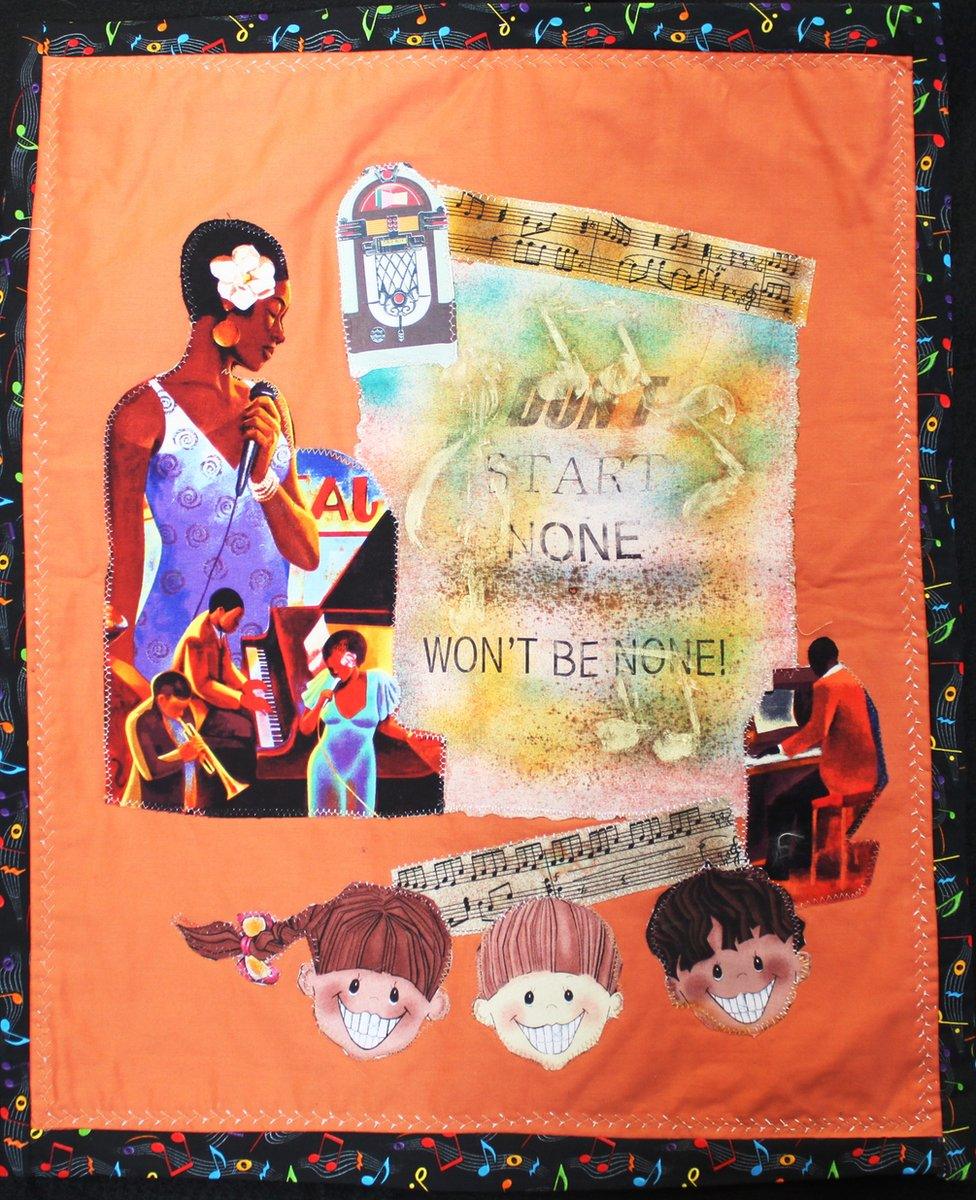
Don't Start None Won't Be None is a quilt in protest at the withdrawal of music and arts education for young children
I became a mother and I made quilts for my children - just the conventional ones with a box pattern - to keep the tradition alive. Years later, my son took his quilt and lay on it to change the oil in his car. He said "It's my quilt!" I said, "Yeah but you don't understand child, you just don't understand."
The next quilts I made were about things that happen to women in the toilet. You know, when you walk out with toilet paper on your heel? Or your dress is in your pantyhose and you don't realise? Or when you go to the toilet in the middle of the night and the seat's been left up and you fall in?
I did a whole series like that. Women thought it was hilarious. Men didn't get it at all.
I went on to do quilts about environmentalism, history, community relations.
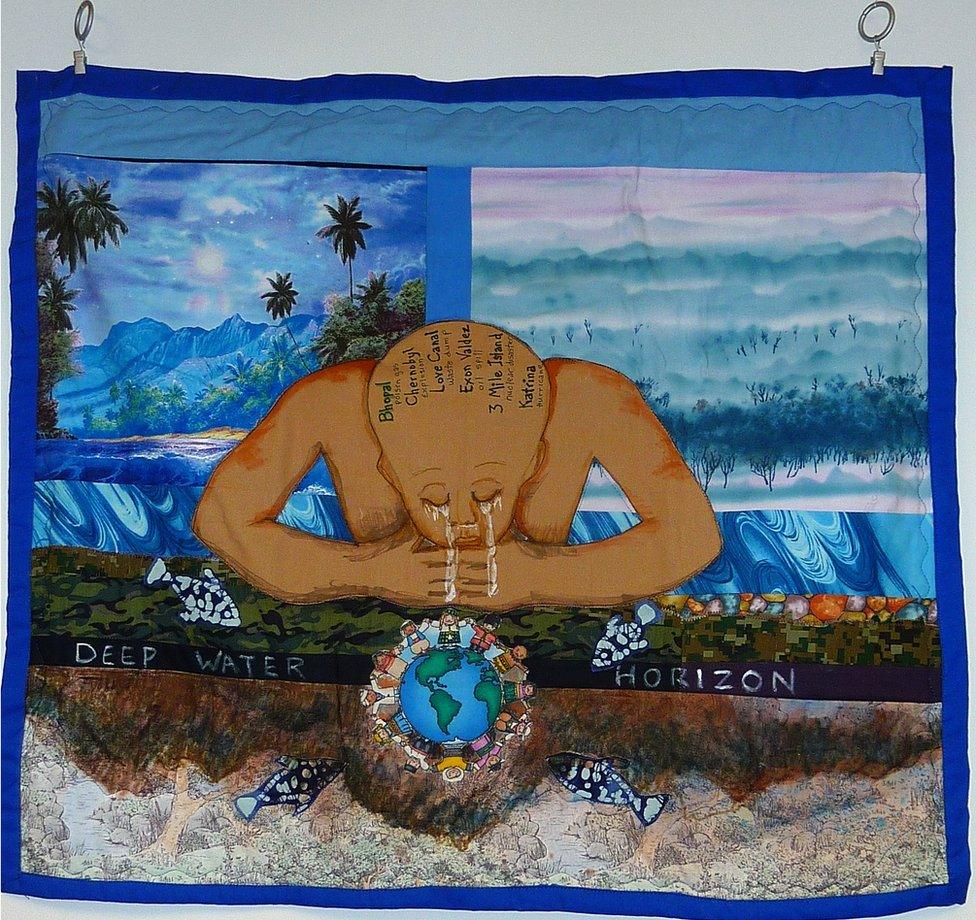
Bonds has travelled to Brazil and Kenya with environmental projects
A quilt has three layers: a top, which is the interesting part; the middle layer, which gives it strength and warmth; and a bottom layer, which holds the whole thing together. The layers used to be tied together with special knots, but I just use a sewing machine.
In all honesty, I still find the process tedious, but the reaction I get at the end is fun.
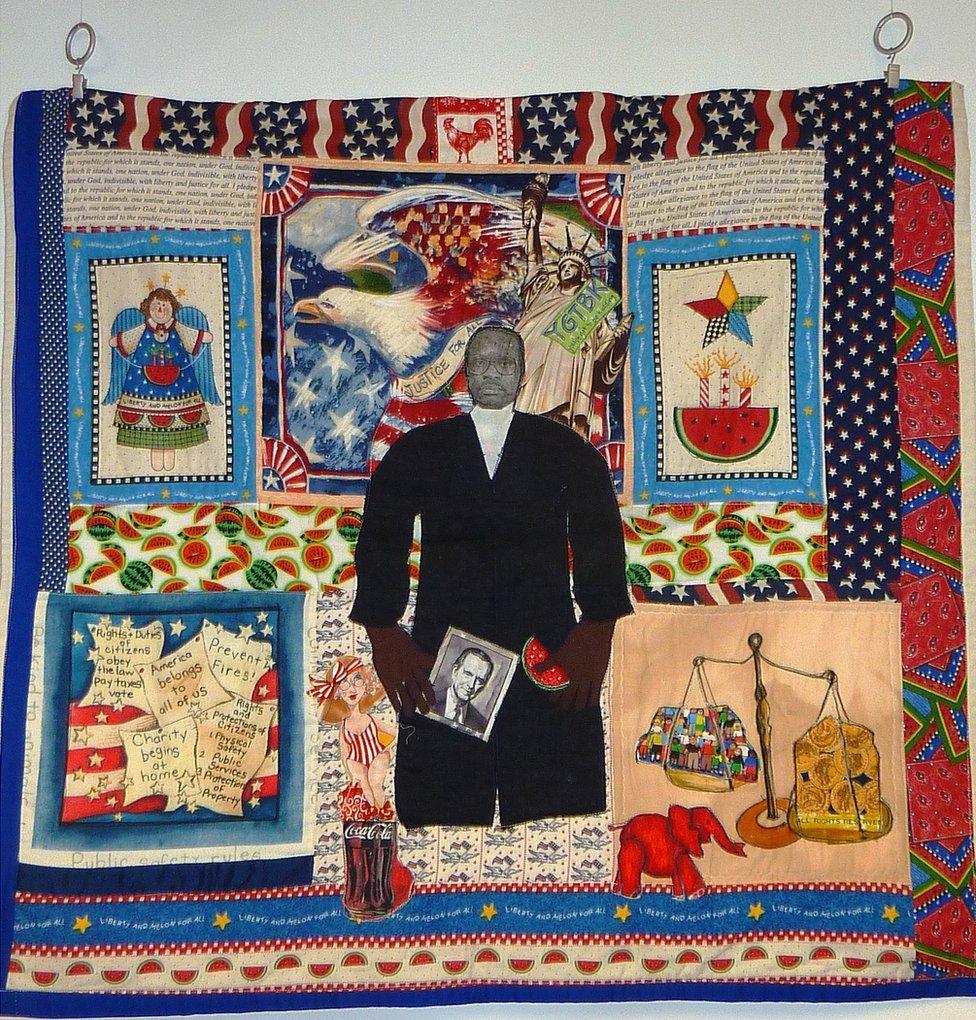
Here Come the Judge is a satirical quilt aimed at Supreme Court Judge Clarence Thomas. Bonds ridicules Thomas by giving him a small head.
Sometimes I work straight through and create a quilt in a couple of days. At the other extreme, I have one that took two years. I created these little beaded masks that were an inch square, and after I'd created about 40 of them I decided to put them all together into a face.
That quilt is called The Kiss from the Ancestors, and it's about the development of jazz, with its African rhythms and European melody. Kansas City was important to the history of jazz.
If my quilts come out pretty that's fine by me, but I'm more interested in getting a message across. This is the way that I alleviate my pain, my resentment, my anger, and it's better than drinking and gambling.
What motivates me to start a piece depends on what's going on. Right now, I'm aware that I need to do something on Donald Trump. I can't make myself do that just yet, but it will happen. I don't want to create art that comes from a place of fear, but to make a statement that's strong and definite.
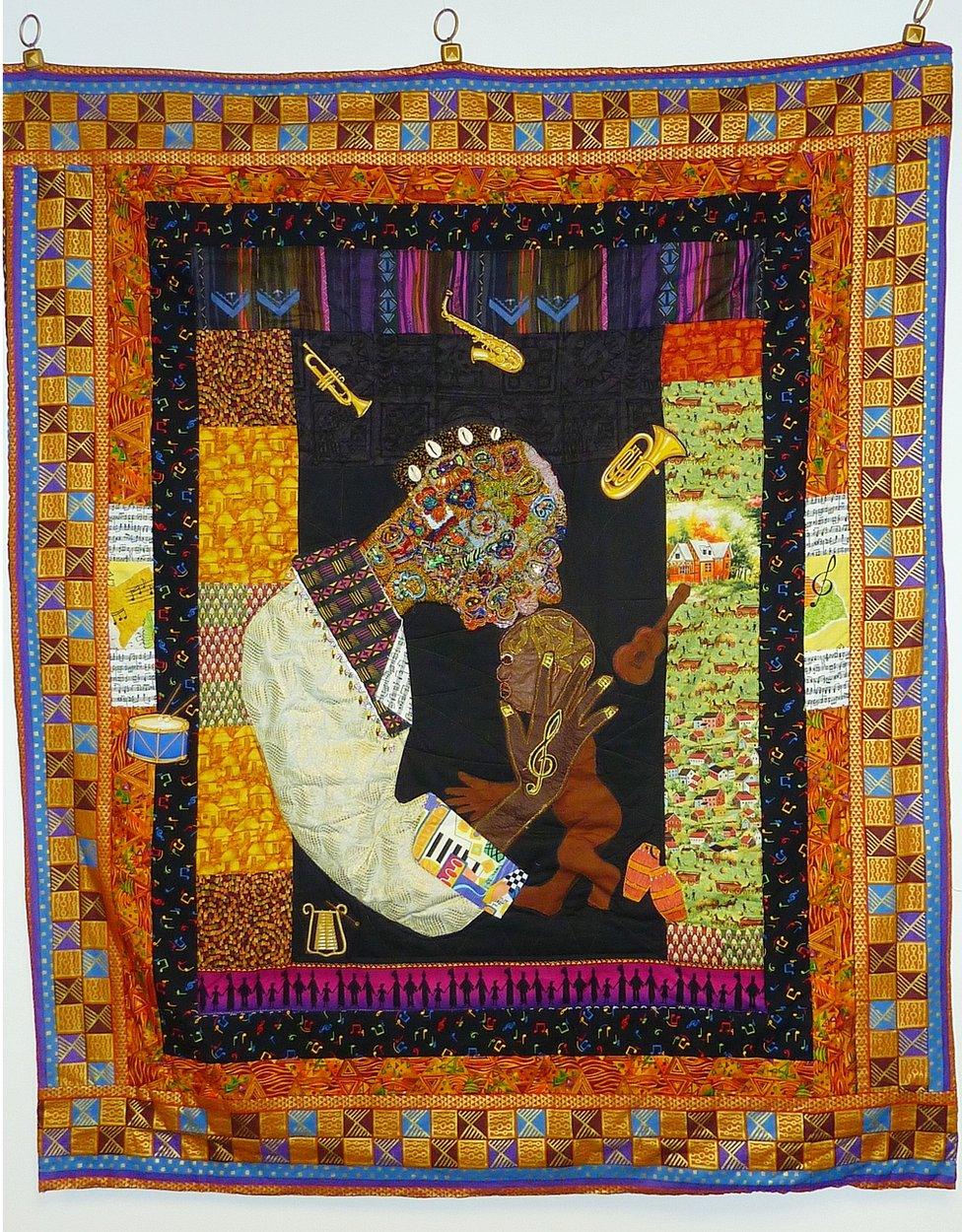
A Kiss from the Ancestors pays homage to Kansas City's significant contribution to the development of jazz music
When the doctor called me to tell me I had third-stage cancer, I just replied "OK…" She said: "Nobody has ever reacted to being told that they have a serious disease with an 'OK'," but I was already thinking about how I could make it into an art project.
One Sunday afternoon soon after getting my diagnosis, I threw a party in aid of Finding Universal Cures to Kick cancer. I chose that name because I had found that when I spoke to women, and mentioned that I had cancer, they often replied with the same expletive.
It was the day before my birthday. I invited about 100 of my activist and my arts friends and we made T-shirts and just had a great time.
This summer I had a double mastectomy and a course of chemo. I'm on the radiation now.

The Whisperer is about the moment "a guy whispers 'I'll be right back'" but he goes off to cheat with another woman. "And she's like the deer in the headlights, not really understanding what's going on, or not wanting to understand what's going on," says Bonds.
My prognosis is wonderful - I'm going to make it through this and I will get a chance to make more quilts and raise more hell.
Inside my cancer centre, there is a gallery that has never been used. The staff just treat it as a big corridor. But as soon as I get better, I'm going to put on a big exhibition there and the first quilt I'm doing is going to be called "The day I became a barcode".
Because that's what they do now, every time you go for a treatment - they put this thing on your wrist, this strip of plasticky paper, with your name, date of birth and a barcode. These medical people are just wonderful, so warm and helpful... but they won't talk to you without swiping your barcode first.
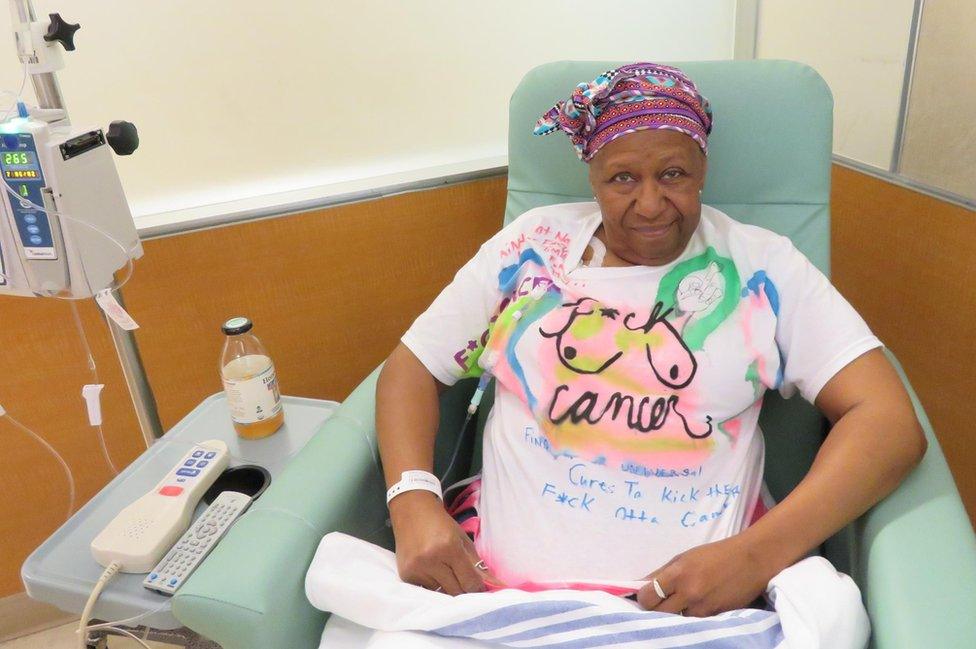
For her final chemo treatment, Bonds wore a T-shirt designed by a 12-year-old at her party
So I'm collecting the fabric for that one right now.
It doesn't feel different to me to do a piece of art about cancer, than it does to do something about going to the toilet, or something overtly political. It's all about me and my body. I have visceral, physical reactions to what happened at Ferguson. I had the same thing when Trayvon Martin was shot dead by George Zimmerman.
My granddaughter called me the other day and said: "Did you hear about the guy who was deaf and they shot him because he did not follow the police instructions? But he couldn't hear them. He was deaf."
I said, "Yeah, I heard about it and I also heard about the one who had autism and they shot his carer and wounded him."
You know, my father was an officer - he rose through the ranks to be a captain in the police department. And it seems to me that the first thing you do as a policeman is not shoot people.
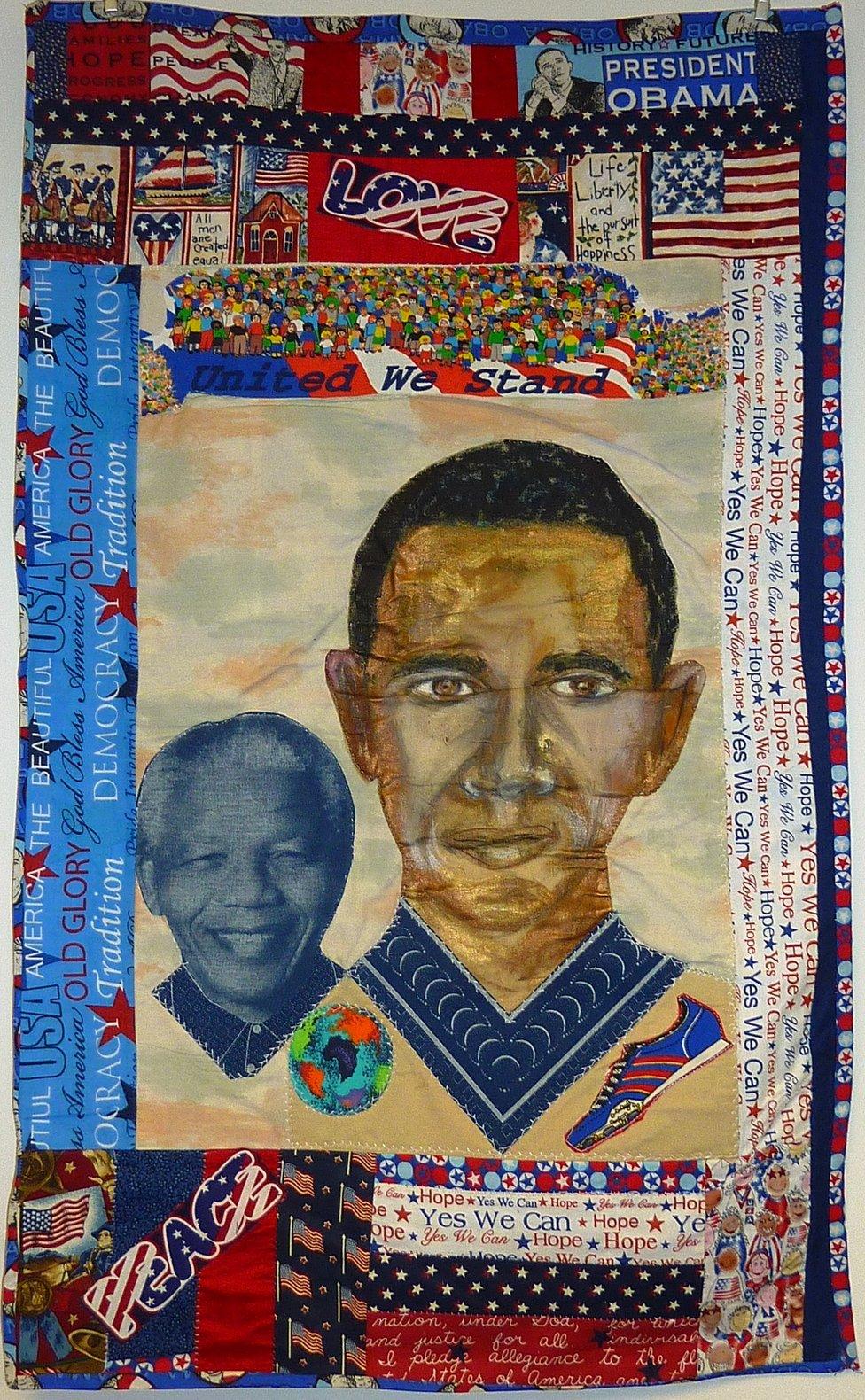
Sons of Africa is a celebration of America's first black president. Bonds attended both Obama's inaugurations and dedicated a series of quilts to him
His father, my grandfather, was a Baptist minister. He and my grandmother lived in a community of Latter Day Saints and were two of very few people of colour in the area. That woman had all those Mormons sign up to the NAACP (National Association for the Advancement of Colored People).
I often think about the legacy I'm leaving my own grandchildren. I'd like them to remember me as doing things, not just as "that woman".
I have done my two granddaughters exactly the same way my grandparents did me. That is to say, as soon as they were old enough to thread a needle I showed them how to make a quilt, telling them: "You have to do this. This is who we are."
So they know how, but they've chosen not to get into quilting right now. I'm guessing they are waiting to find a reason.
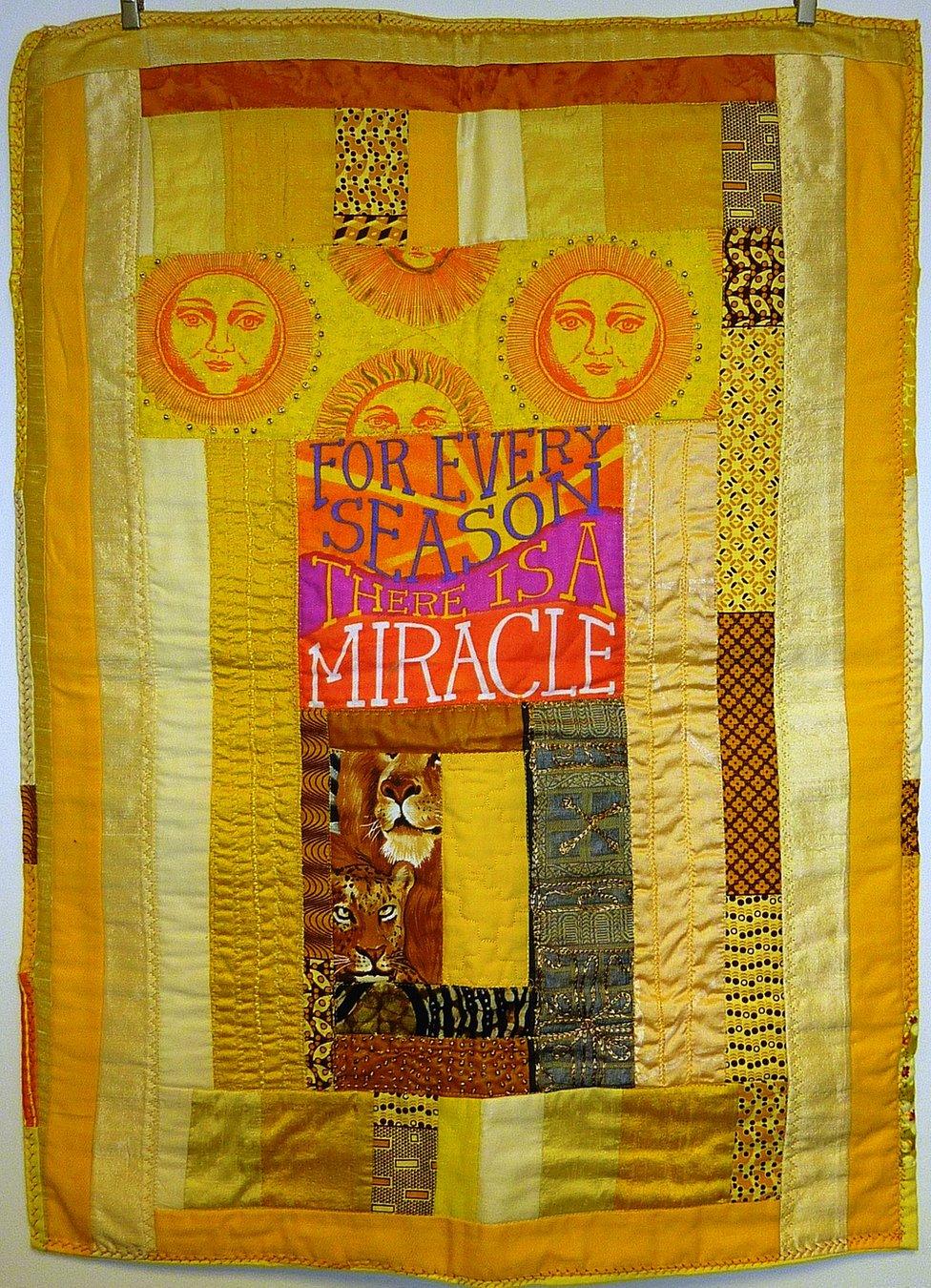
The Yellow Miracle is one of a series of quilts devoted to vibrant and symbolic colours
As told to @williamkremer, external.
Listen to Nedra Bonds speaking to Outlook on the BBC World Service. Join the conversation - find us on Facebook, external, Instagram, external, Snapchat , externaland Twitter, external.